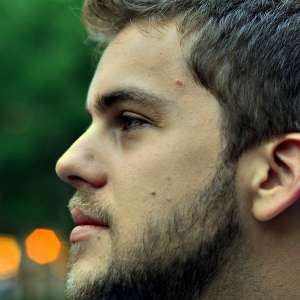An outstanding lineup of soloists joined Bernard Labadie at Carnegie Hall Sunday for a performance of J.S. Bach’s St. John Passion. Hearing Labadie conduct his own ensemble Les Violons du Roy and the chamber choir La Chapelle de Québec with such a superb group of soloists was truly a treat indeed.
Ian Bostridge, who received hearty, well-earned bravos, gave an incredible performance as the Evangelist. Many audience members unfamiliar with the many delights of baroque music may start to snooze during long passages of unaccompanied recitative. However, Bostridge was engaging throughout the entire performance, telling the story of Christ’s crucifixion with heart-wrenching piety.
The sumptuous soprano Karina Gauvin was a delight to hear – even though the score only affords two arias for her voice type, “Ich folge dir gleichfalls mit freudigen Schritten,” and “Zerfließe, mein Herze, in Fluten der Zähren.”
The young bass-baritone Hanno Müller-Brachmann sang admirably in the roles of Peter and Pilate next to the more seasoned bass-baritone Neal Davies in the role of Jesus. Tenor Nicholas Phan compared less-favorably to the more singular and experienced Ian Bostridge. Phan’s instrument is remarkable indeed, and he is a musician to follow in the coming years as he matures as an artist. At times, however, he seemed to strain too much, especially in the upper register, and sounded less impressive singing alongside Bostridge. Earlier this season on the same stage, he stood out among younger singers when singing Bach’s Magnificat under the baton of Robert Spano. But the line-up of solists in Sunday’s performance could hardly be matched.
La Chapelle de Québec performed the choruses, which variously participate in and comment upon the action of the Passion story. The eight-to-a-part ensemble was strong yet lithe enough to realize Bach’s dense but elegant choral writing.
When performing big works like Bach’s Passions or his B minor Mass, conductors since the nineteenth century have assumed that large performance forces are needed to match the grandeur of the piece, using one hundred or more singers for a piece like a Bach Passion. Having such a large choral ensemble obscures the grace in Bach’s choral writing especially. Not to mention, it’s a tall order asking twenty-five sopranos to add a cadential trill here and there. With Labadie’s eight-to-a-part ensemble, the music had room to breath, even in passages with dense imitative textures. The chorales were stately and graceful; music fitting of Christ the “King.”
The difficult instrumental obbligati in the St. John Passion demand a top-notch ensemble – and the players of Les Violons du Roy certainly delivered. For example, the dramatic heart of the Passion announcing the death of Jesus is a lament for alto with viola da gamba. Gambist Emily Walhout gave an exceptional performance, outshining even the soloist, male alto Damien Guillon.
In the arioso “Betrachte, meine Seel,” archlute player Sylvain Bergeron proved that early instruments aren’t too “soft-spoken” for venues like Carnegie’s Isaac Stern Auditorium.
Since the cello is the unsung hero of the whole Passion (and many works of the Baroque era, large and small), Benoît Loiselle and Raphaël Dubé deserve special mention for so sensitively shaping the bass line. At times, as in the recitative “Die Schar aber und der Oberhauptmann,” the cello was just as expressive as (or maybe more than) Ian Bostridge.
Organist Richard Paré and harpsichordist Thomas Annand played well – though perhaps Labadie called for harpsichord in a few too many sections of the score. The excitement of playing this repertoire, or at least part of it, is the flexibility of the continuo section, which allows conductors to affect contrasts of timbre even within a single movement by choosing which instruments play when. In an aria like “Von den Stricken” which calls for oboe obbligati, conductors often give the harpsichord a break, and allow “softer” instruments, such as the archlute, to play choral accompaniment alone. Labadie, however, called for harpsichord in this aria and others, which may have been best without it. Though I love a robust continuo section (as a harpsichordist myself), sometimes less is more.
The Bach Passions have become a seasonal cottage industry for almost two centuries, ever since Mendelssohn’s revival of the Matthew Passion in the late 1820s. Bach, of course, was not the only one to create dramatic musical settings of the passion of Christ – the tradition dates back well into the middle ages. At this point in the history of the early music revival, are we ready to introduce a Passion by, say, Schütz? Conversely, what about more recent musical settings such as the St. Luke Passion (1963–6) by Krzysztof Penderecki and the St. John Passion (1982) by Arvo Pärt?
Labadie is certainly known for introducing “new old” repertoire to modern audiences. Recently this season, he conducted performances of lesser-known works by Telemann, Sammartini, and Geminiani with great success. Perhaps in the future, Carnegie will consider inviting him back to kick off “Passion season” with different, yet equally satisfying Passion settings. After all, other institutions in New York are expanding the palette of their audiences; the Met presented the baroque pastiche The Enchanted Island with great success earlier this season, and New York City Opera will mount Telemann’s rarely revived Orpheus in just a few weeks. What’s to say subscribers at Carnegie wouldn’t welcome one of Telemann’s many passions?


